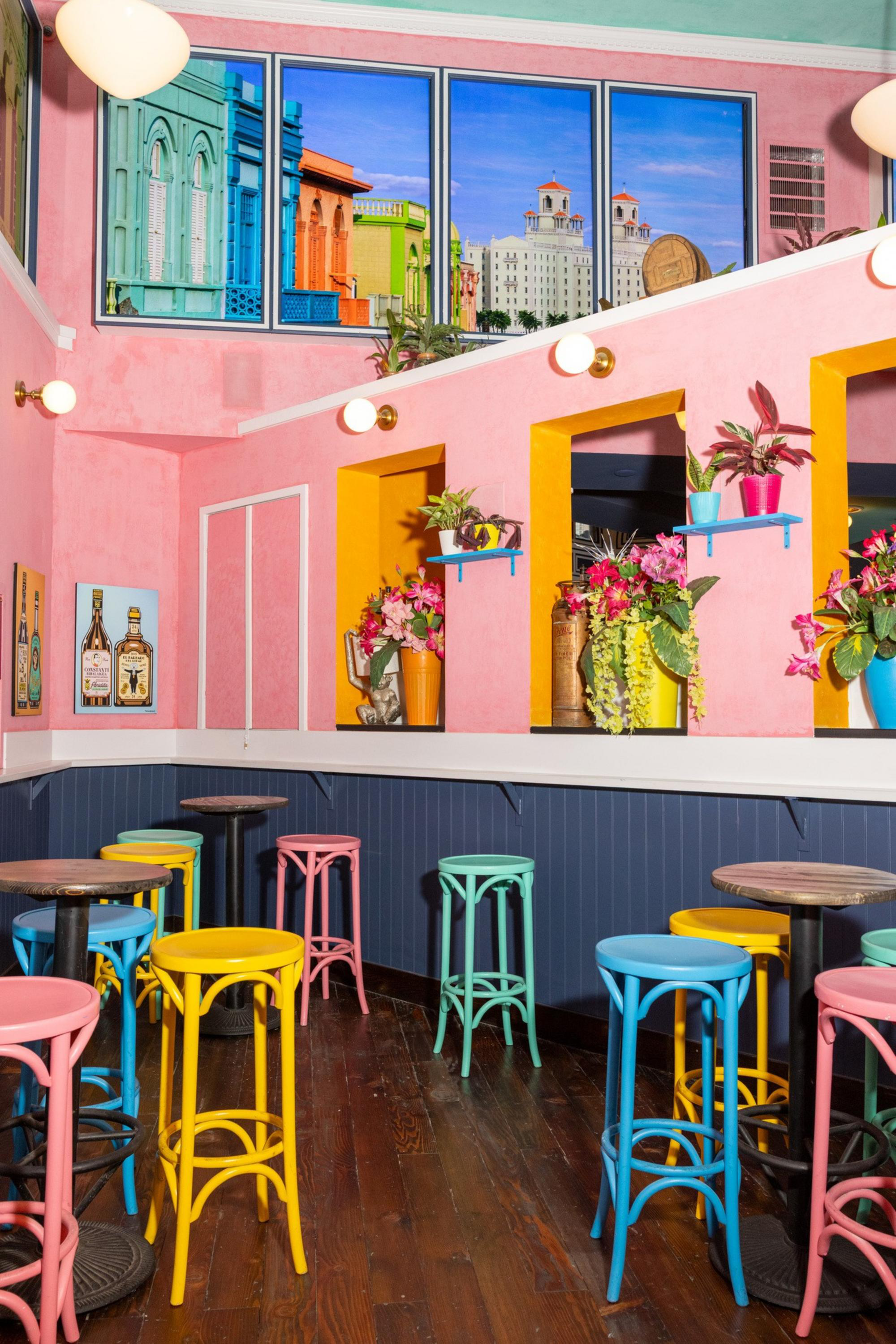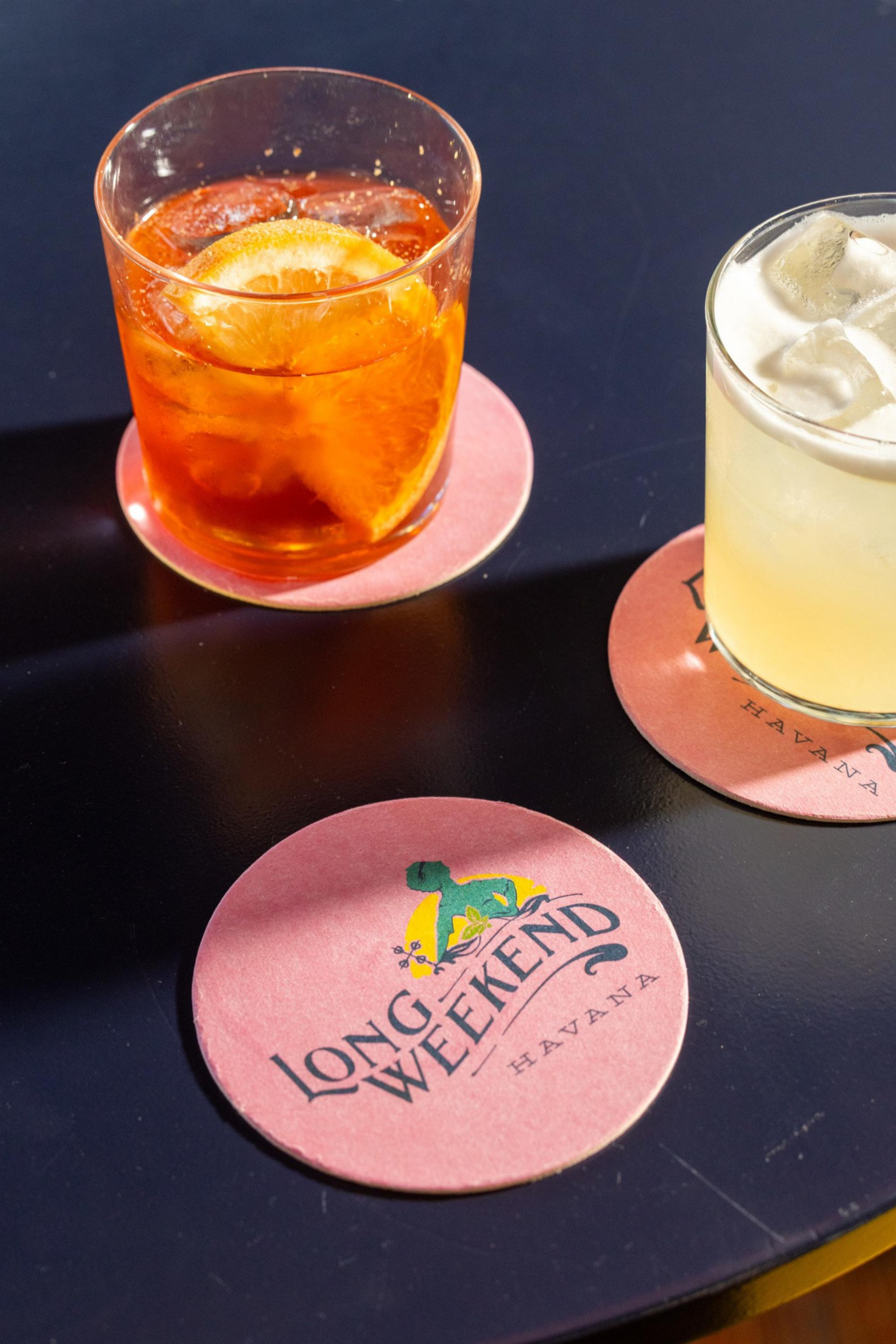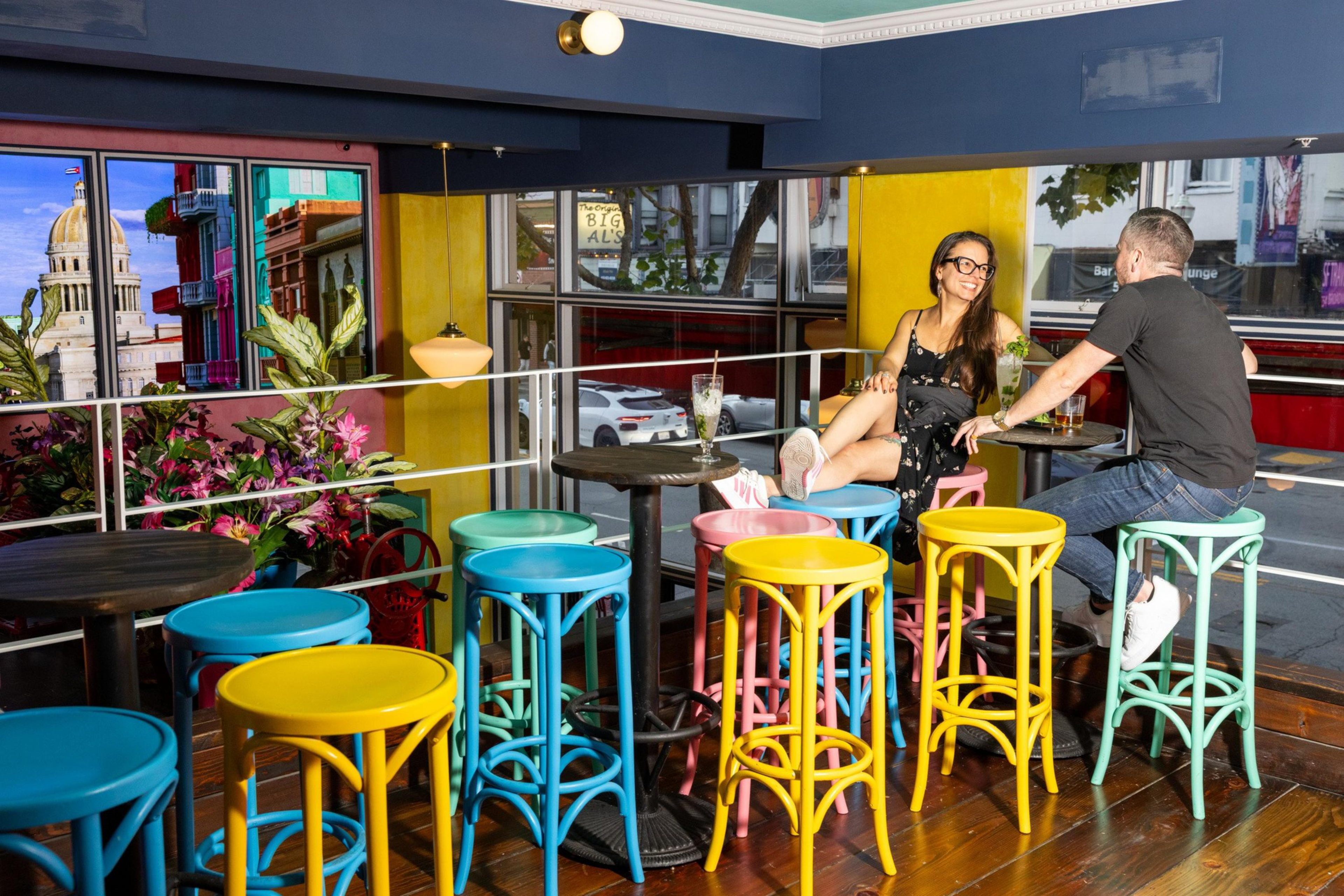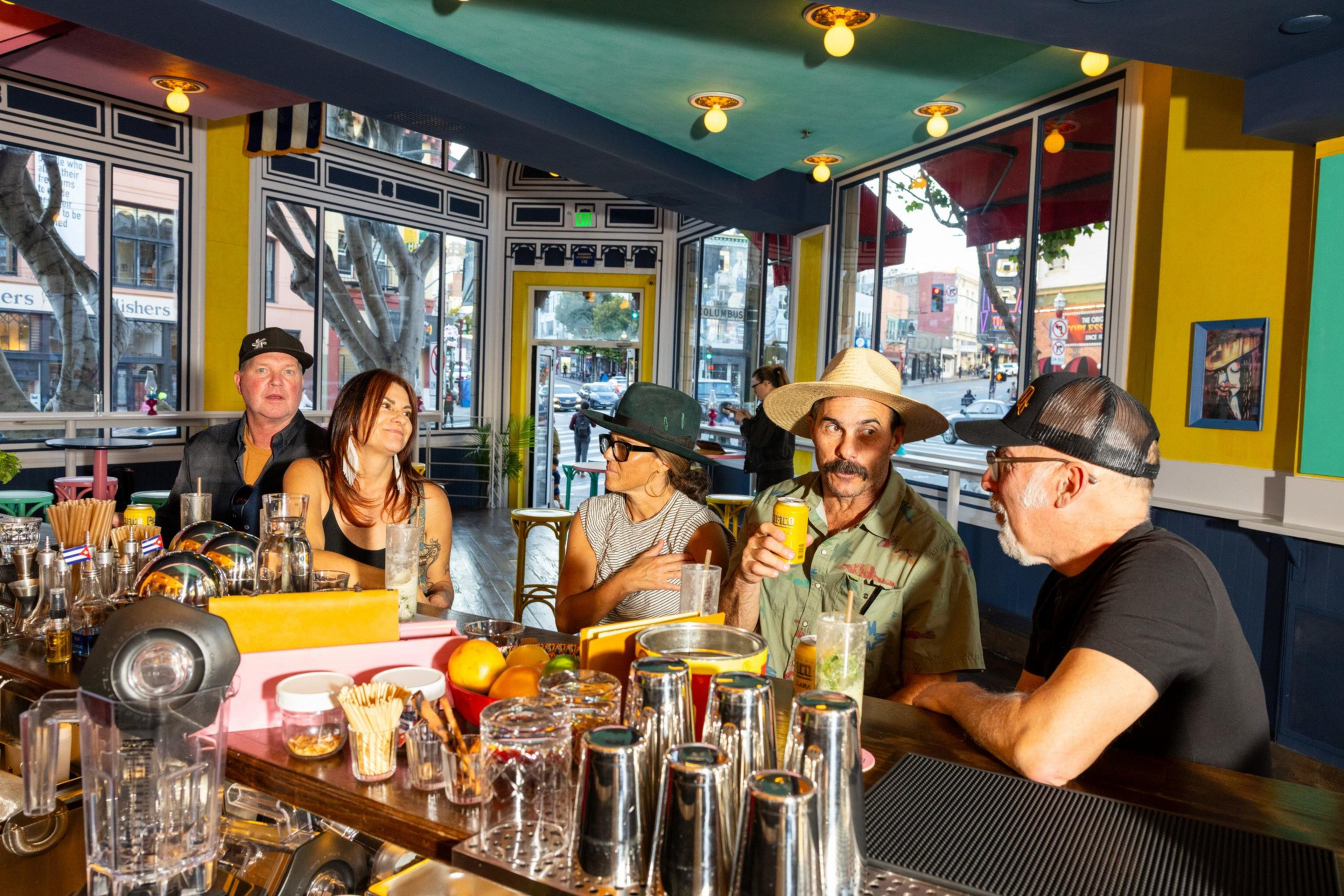A five-piece salsa band plays songs of love. LED screens display the Spanish colonial skyline of Havana at sunset. Pastel-colored stools are clustered in quartets on the main floor and the mezzanine. One story below, the basement is covered in graffiti, meant to evoke the Cuban capital’s seamy underbelly.
This is opening night at Long Weekend (opens in new tab), the newest nightlife destination in ever-hipper North Beach. Constructed in 1923 to house the Italian American Bank, the building at 270 Columbus Ave. most recently played host to the Roman-style pizza-and-pasta joint È Tutto Qua, which shuttered in 2020.
Now it’s North Beach’s newest cocktail bar, where guests sip complex, Cuban-themed drinks like the Malecón Tropical, a passion-fruit-forward spin on a boulevardier, or the obscure, rum-and-butterscotch canchánchara. The latter is a favorite of owner Brian Sheehy, CEO of prolific hospitality group Future Bars (opens in new tab). “The only other time that I had it was in Havana,” says Sheehy, a Cuba-phile who visits the island regularly with the help of his Irish passport. “I’ve never seen it on a menu anywhere else.”


Long Weekend, which opened Oct. 23, isn’t just Sheehy’s newest venture. It’s also a we’re-so-back declaration for Future Bars, a once-dominant nightlife player that hitched its wagon to downtown San Francisco’s star during the 2010s — only to get mired in the FiDi’s prolonged slump since the pandemic. Now, Sheehy is once again betting on happy-hour crowds and thirsty business travelers. But he admits this is a tough time for his industry.
“It’s very challenging to think about opening another bar, another bar, another bar,” Sheehy says. Amid rising costs and changing drinking habits, his formula for success is no longer a lock. So instead, Future Bars is trying something different. Long Weekend is a long-term project, but everything Cuban-related in it — graffiti, pastels, torched cinnamon sticks — will be gone in nine months.
A wobbling nightlife empire
Long Weekend isn’t Future Bars’ first foray into North Beach; the company also operates The Devil’s Acre (opens in new tab), an ode to the Barbary Coast era. In total, the group operates 13 bars, plus two locations of the artisanal liquor store Cask (opens in new tab). Themed or not, they share a similar atmosphere, geared toward knowledgeable, sophisticated, “adult” drinkers.
It’s a template that, for the better part of two decades, has worked well. Future Bars started in 2004 with Swig (opens in new tab), a lounge a few blocks west of Union Square. A year later saw the debut of the phenomenally successful Tenderloin hideaway Bourbon & Branch (opens in new tab). Concealed to this day behind a tongue-in-cheek sign for the “Anti-Saloon League,” it almost single-handedly sparked the city’s late-aughts speakeasy revival.
Then the floodgates opened, and a series of projects appeared in rapid succession downtown. Some, like tiki bars Pagan Idol (opens in new tab) and Zombie Village (opens in new tab) or the vintage-newspaper-filled Local Edition (opens in new tab), have strong visual conceits. Nightingale (opens in new tab) is a 1970s-style “fern bar.” Rickhouse (opens in new tab) is known for its whiskey collection. Ginger’s (opens in new tab) is one of the few LGBTQ+ venues outside SoMa or the Castro. The Dawn Club (opens in new tab) is a jazz bar. The Lark (opens in new tab) is for watching sports.
But Sheehy is candid that the edifice has been crumbling. The attorneys, day-traders, and other professionals whose offices dot Kearny Street have switched to hybrid and remote work, and Rickhouse and Nightingale have not recovered as he’d hoped. “They don’t need to come to the FiDi anymore, and they never will,” he says of the formerly reliable office hordes.
Consequently, Sheehy may be the man behind the city’s largest nightlife empire, “but it’s a failing empire,” he says.

A new playbook
Despite these challenges, Future Bars, which has approximately 220 employees, needs new projects in order to nurture and retain talent. “We need an outlet for our younger staff to say, ‘OK, I want to be the general manager of that bar,’” Sheehy says. “If we tell them we’re not opening any more bars, they’re not going to stick around.”
Long Weekend’s rotating theme model represents one major shift for Future Bars — an attempt to meet the need for expansion without overextending. “Instead of finding a new location every six or 12 months, we’re going to stick with this one and use it as a platform to test out new concepts,” he says. Nine months from now, Long Weekend will pivot away from Havana, probably to a Mexico City-themed concept. Possibly Paris. Or maybe Tokyo.
Like nearly every other hospitality company, Future Bars has grappled with demographic shifts. Young patrons have shorter attention spans, drink less, and age out of heavy bar patronage quickly, Sheehy says. The company’s bars aren’t geared toward people right out of college but toward those in their mid-20s who’ve begun to tire of loud venues where they wait five-deep for a drink.
To succeed, Future Bars must also draw in business travelers. High hotel occupancy and convention traffic are the company’s bread and butter, and the closer a bar is to the Moscone Center — Local Edition and The Lark are each just three blocks away — the better it’s doing.
Beyond that, Long Weekend is making a play for well-heeled patrons to envision the space as more than a bar. Its VIP “Keyholder Club (opens in new tab)” grants members access to custom rum blends and personalized tasting glassware — plus the ability to stash pricey bottles of booze in safe-deposit boxes for on-site consumption.
Will these bells and whistles be enough? “Everyone wants the new hottest thing,” Sheehy says. Indeed, the future of Future Bars may depend on it.
